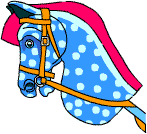Dada
Created | Updated Jan 28, 2002

Dada is French for "hobby horse". It's believed that the people who started Dada, under pressure from others who wanted them to call it something else, stabbed a knife randomly into a dictionary, and 'dada' was where the knife landed. That's a fallacy of course.
This artistic movement began in 1916, or thereabouts, in the city of Zürich, Switzerland. It was created by a group of artists who had migrated from other countries for various reasons. Some felt oppressed. Some were banished for expressing themselves. Others were social misfits.
The Dada movement was a protest against oppressive governments that tried to shut up the creative muse and the independent spirit. Dadaists preached and created art that retaliated against the folly of war1. They had unconventional public demonstrations and exhibitions of work that made many stand up and take notice. They provoked a strong emotional response.
Dada quickly spread to Paris, Berlin, and even across the Atlantic to New York City. Dada ranted and railed against conventionally accepted aspects of society, challenging the status quo and questioning authority.
Nothing was sacred! Everything was mere fodder for Dadaist questioning and ridicule. Common objects, normally taken for granted, were often praised as artistic triumphs and practically worshipped, before being ripped to shreds and stomped on before a live audience of confused and bewildered people. Artists such as Man Ray, Max Ernst, Marcel Duchamp, and Hans Arp were just a few of those who moulded and shaped Dada into something quite perversely erotic.
Dada can be seen as a series of socio- patrio- psychologic- anarcho- materialistic experimental... things. Sometimes Dada artists would do something not to create art, but to instigate art in the audience. A bonfire of all the art created that night might be an example. Artists, after allegedly slaving over grandiose works of art and presenting them to the audience, would start a large fire and throw their works of art into the fire, just to see what the audience would do, if anything. Spontaneity and improvisation were the order of the day. Dada artists would break barriers by acting first and thinking later, taking their audience hostage or threatening to mow them down with farming equipment, for example.
Censorship was forbidden within the tenets of the movement. This Expression Unchained gave birth to a plethora of new art forms and new perspectives on old artistic forms of expression. The Dada movement lasted only a decade or two. Most art historians believe it evolved into the slightly less unpredictable, but no less perplexing, Surrealist art movement.
Though Dada is no more, its influence has helped shape most fine art and commercial art for the better part of the 20th century. What we take for granted now in modern day marketing and advertising was forged in the Dada movement. Such things as the concept of large posters with bold text superimposed over images, practically unthinkable prior to the Dada movement, are now commonplace. Modern day comedy and improvisational theater also owe much to Dada.

